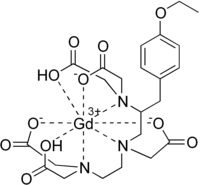
Photo from wikipedia
Purpose: This study aims to identify the hallmarks of gadoxetate disodium-enhanced magnetic resonance imaging distinguishing hepatocellular carcinoma (HCC) from hypervascular liver metastases (HLMs). Methods: Between January 2008 and October 2020,… Click to show full abstract
Purpose: This study aims to identify the hallmarks of gadoxetate disodium-enhanced magnetic resonance imaging distinguishing hepatocellular carcinoma (HCC) from hypervascular liver metastases (HLMs). Methods: Between January 2008 and October 2020, among patients who underwent gadoxetate disodium-enhanced MRI, those who met the following criteria were retrospectively included: without chronic hepatitis or liver stiffness ≤ 2.5 kPa on magnetic resonance elastography or F0/F1 on pathological assessment. Two blinded radiologists reviewed the imaging findings to judge the presence or absence of the enhancing capsule, nonperipheral washout, corona enhancement, hypointensity in the transitional/hepatobiliary phase (HBP), hyperintensity on T2-weighted/diffusion-weighted imaging (DWI), mosaic architecture, and blood products/fat in mass. The lesion-to-liver signal intensity ratios in HBP and DWI were also calculated. Univariate and multivariate analyses were performed to identify the imaging hallmarks distinguishing HCC from HLM. Interobserver agreement was calculated using kappa values and intraclass correlation coefficients (ICCs). Results: The final study cohort comprised 72 lesions in 44 patients (mean age, 65.0±11.9 years). Univariate analysis revealed higher frequencies of the following features in HCC than in HLM (P < .10): nonperipheral washout, corona enhancement, transitional phase hypointensity, mosaic architecture, and fat in mass (P = .002-.073). Multivariate analysis revealed that nonperipheral washout and mosaic architecture favored the diagnosis of HCC over that of HLM with odds ratios of 7.66 and 14.6, respectively (P = .038 and .029, respectively). The interobserver agreement for each item was moderate or substantial (kappa or ICC = .447-.792). Conclusion: Peripheral washout and mosaic architecture may be reliable imaging hallmarks for distinguishing HCC from HLM.
Journal Title: Canadian Association of Radiologists Journal
Year Published: 2022
Link to full text (if available)
Share on Social Media: Sign Up to like & get
recommendations!